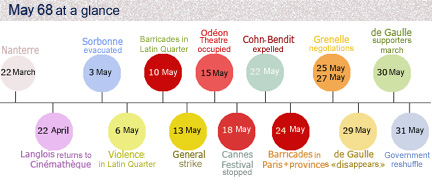Chronology
Timeline May 68
Article published on the 2008-05-11 Latest update 2008-05-14 11:20 TU
22 March. A group of around 100 students, mainly anarchists and Trotskyists, occupy administrative buildings at Nanterre University near Paris in protest at sanctions imposed on anti-Vietnam War activists. The Movement of 22 March is founded with Daniel Cohn-Bendit as its leader.
29-30 March. Classes are suspended at Nanterre.
22 April. Henri Langlois, an emblematic figure of French cinema, returns as head of the Cinématheque, the French film institute. This followed more than two months of protests by French and foreign filmmakers and actors against government attempts to take control of the organisation by naming a new director.
1 May. International Workers' Day march: tension mounts with the rumour that Occident, a far-right student movement, is planning to attack Nanterre University.
2 May. Part of the student union building at the Sorbonne is burned down. Occident is blamed. Students at Nanterre prepare a face-down with the “fafs” (fascists). Daniel Cohn-Bendit and seven other members of the movement are called in front of a disciplinary commission over events on 22 March.
3 May. The Dean of Nanterre closes down the campus. Students head to the Sorbonne to meet with far-left organisations. The Dean of the Sorbonne authorises police to evacuate the premises and students clash violently with police in the Latin Quarter, which surrounds the unviersity. The first paving-stone is thrown at police. More than 100 people are injured, 20 seriously. Hundreds are arrested and the Sorbonne is closed.
6 May. Further student demonstrations in the Latin Quarter. Police put up the first barricades. Six hundred students and 345 police officers are injured. Four hundred twenty-two people are arrested and the protest movement starts to spread to the provinces.
10 May. Police reinforcements arrive in Paris to guarantee the safety of delegations involved in negotiations between the United States and Vietnam. Students demonstrate in the Latin Quarter, resulting in violent clashes with the police. Paving-stones are thrown. The CRS (riot police) launch an assault during the night (named the "night of the barricades"). Three hundred sixty-seven people are seriously injured, including 251 police and 102 students. Four hundred sixty-eight people are arrested, 60 are cars burned. Shocked by the heavy-handed reaction of the police, the general public sides increasingly with the students.
13 May. Trade unions (CGT, CFDT, FEN) and left-wing parties call a 24-hour general strike in support of the students. An estimated 800,000 people - teachers, union members and many politicians - flock onto the streets of Paris. Prime Minister Georges Pompidou seeks to calm the situation by announcing the re-opening of the Sorbonne. Students immediately take possession and proclaim its permanent occupation. Debates and meetings are held around the clock.
14-19 May. President Charles de Gaulle is on official trip to Romania. Students occupy the Odéon theatre, a cultural symbol of the bourgeoisie, which becomes the centre for revolutionary cultural and social activity. Upon his return to France, de Gaulle tries to bring the situation under control saying "Reform yes, havoc no".
18 May. The strike, originally confined to the private sector, extends to public services. At the Cannes Film Festival three jury members resign; filmmakers Alain Resnais and Carlos Saura withdraw their films from the competition. The organisers close the festival the following day.
22 May. More than eight million people are on strike in France. Daniel Cohn-Bendit is refused re-entry to France after a "revolutionary" tour of Germany.
24 May. In a television broadcast de Gaulle tries to win back public opinion by proposing a referendum. The speech has little impact and protesters call for his resignation. Violence in the Latin Quarter with 456 injured and 795 arrests. Fighting also breaks out in Strasbourg, Bordeaux, Nantes and Lyon where a police officer is crushed to death by a lorry.
25-27 May. Negotiations begin between government, trade unions and the employers’ federation at the Ministry of Social Affairs, rue de Grenelle (called the "Grenelle Accords"). The result of the negotiations: an increase in the minimum wage by a third and the establishment of an official right to a union section in every company. Some hard-line factions reject the accords and continue striking. Daniel Cohn-Bendit returns secretly to France.
29 May. De Gaulle cancels a cabinet meeting and disappears. The French Communist Party demands a "people's government".
30 May. De Gaulle returns from Baden Baden (Germany), having sought support from General Jacques Massu, head of the French armed forces. De Gaulle makes a radio broadcast announcing he has “come to terms with [his] second thoughts”. He refuses to resign, but he dissolves the National Assembly (parliament). That evening, hundreds of thousands of the de Gaulle's supporters and the so-called “silent majority” march down the Champs-Elysées in Paris.
31 May. Prime Minister Georges Pompidou announces a government reshuffle. Throughouit France, people demonstrate in support of de Gaulle.
June. The majority of public and private-sector workers return to work but sporadic violence continues. In separate incidents between police, students and workers, three people die.
23 & 30 June. First and second round of general elections, where parties close to de Gaulle win massive victories.
10 July. De Gaulle appoints Maurice Couve de Murville as Prime Minister.








